What Csn You Feed a Wild Box Turtle
You are what you eat – and your box turtle is, too!
One of the most significant foundations for health and longevity in box turtles is their diet. That goes for just about any other animal, too, including humans.
You'll have to take things like food groups, quantities, and feeding frequency into consideration, along with other factors like the animal's age, the time of year, and the animal's current health status.
As our pet's caretaker, our goal should be to mimic its natural diet as much as possible.
Below, we'll discuss the foods they've evolved to eat over hundreds of years, along with several other tips and ideas to help you keep your box turtle healthy and happy.
What do Box Turtles Eat?
Box turtles are considered omnivores, with a healthy appetite for insects and fruits, especially.
What Box Turtles Eat in the Wild
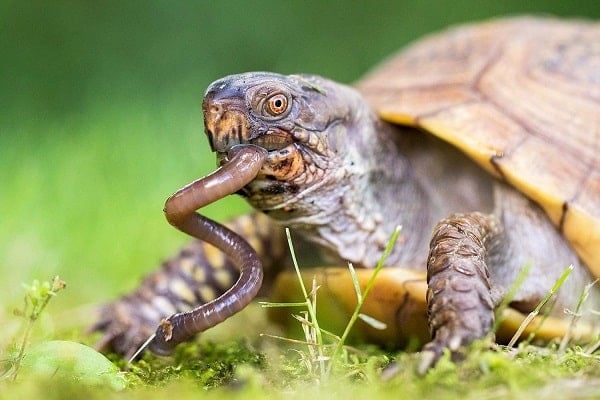
With six species and even more subspecies spanning across North America, diet can vary somewhat, depending on which locality you're caring for.
As we previously mentioned, the healthiest diet for a box turtle closely replicates its diet in the wild.
A wild box turtle's diet typically consists of:
- Earthworms
- Snails
- Spiders
- Caterpillars
- Grasshoppers
- Millipedes
- Crayfish
- Fish
- Frogs
- Fallen fruit (often over-ripe or rotten)
- Berries
- Flowers
- Grass
- Cacti
- Mushrooms
What Pet Box Turtles Eat in Captivity
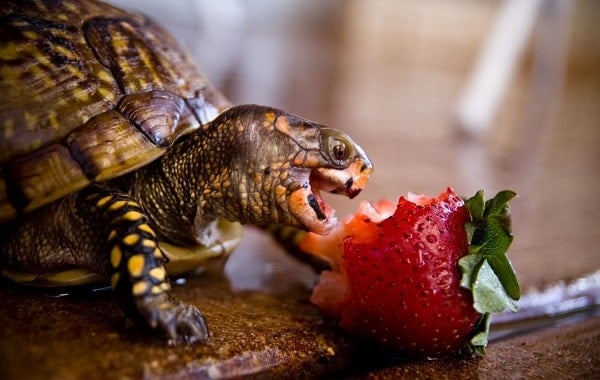
Naturally, many of these food sources aren't readily available to box turtle owners, so a captive box turtle's typical diet varies significantly from a wild box turtle's.
Still, the foods on this list are quite suitable and enjoyable for most box turtles.
Box turtles in captivity as pets eat the following:
- Shredded carrots
- Shredded squash
- Green beans
- Softened dog kibble
- Berries
- Melon (with the rind)
- Greens such as mustard, dandelion, swiss chard, and collard
- Flowers such as hibiscus, rose petals, geraniums, nasturtiums
- Sweet peppers
- Green beans
- Cooked chicken
- Eggs
- Beef heart
- Mealworms
- Superworms
- Earthworms and nightcrawlers
- Pinky mice
- Crickets
- Commercial box turtle diet
Baby Box Turtle Diet
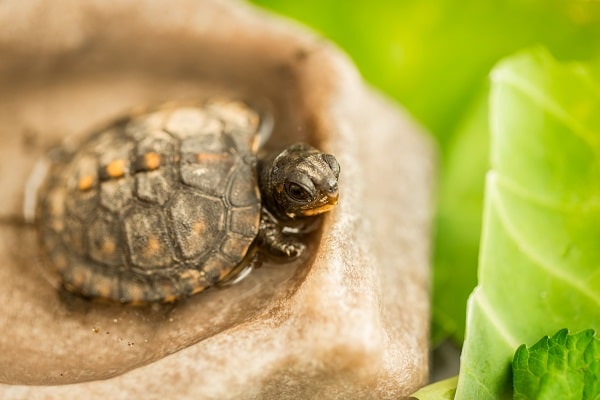
Hatchling box turtles require a different diet for the first twelve months of their life. They should be fed every day, although it is fine and probably healthy to limit their intake to a small snack on some days.
Like adult box turtle diets, the nutritional needs of young boxies are not fully understood.
Some sources report that they are entirely carnivorous. While it is true that they have higher protein needs than their fully-grown counterparts, it's beneficial to offer baby box turtles vegetables and fruits with every meal.
Expert Tip: Since your baby box turtle's diet will be high in protein, it will probably be low in calcium. At this age, it is imperative to dust foods with phosphorus-free calcium powder to achieve the appropriate ratios. This is necessary for healthy bone and shell growth.
Your baby box turtle may ignore the plant material (more on this later), especially in the first few months of life, but don't panic. This is fine. Even exposure to the sight and texture of these healthful foods is beneficial.
Most animals will eventually crave or be attracted to foods packed with vitamins that they may be deficient in.
Let Mother Nature take the lead and allow your baby turtle to pick what it wants to eat, with an emphasis on protein, but with vegetables always included in the offering.
Adult Box Turtle Diet
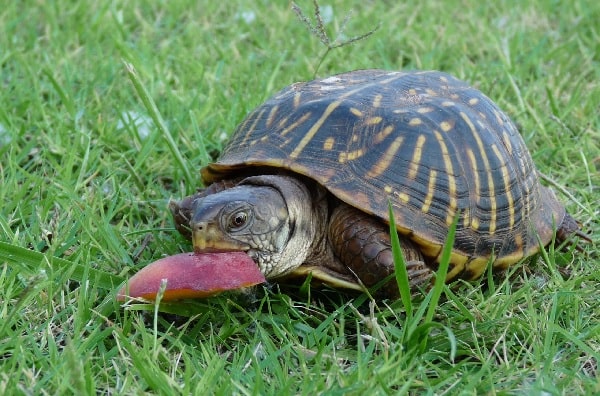
As a box turtle reaches adulthood and finishes growing, their caloric needs decrease.
To accommodate their changing bodies, cut back "big" feeding days to as often as once every other day, or as little as once every three days.
Use your boxie's appetite, activity level, and body condition as your guidance.
On non-feeding days, you may still opt to offer some of your turtle's favorite treats as a small snack.
As with most reptiles, it is probably not harmful – and perhaps even beneficial – to let your box turtle fast entirely once every week or so.
Regarding diet composition, current recommendations are listed below, along with numerous healthy examples in each food group.
In most cases, the options listed are from best to worst in terms of calcium content, fiber content, and overall nutritional value for boxies.
Protein – 50%
All raw meat should be cooked. Many of the insects below are available live (best), canned or bagged moist (better), or freeze-dried (OK).
Avoid purchasing insects from a bait shop.
Remember to dust low-calcium protein sources with reptile calcium powder, crushed cuttlefish bone, or crushed eggshell.
Examples of suitable box turtle food from this group are:
- Black soldier fly larvae*
- Earthworms and nightcrawlers*
- Waxworms
- Mealworms
- Super worms
- Butterworms
- Silkworms
- Hornworms
- Beetles
- Crickets
- Roaches
- Grasshoppers
- Sowbugs
- Spiders
- Snails and slugs
- Shrimp
- Feeder fish
- Anoles
- Poultry meat and organs
- Commercial turtle diet
- Moistened dog food
- Beef meat and organs
- Pork meat and organs
- Eggs
- Frozen/thawed pinkie mice
Other Vegetables – 30%
Tough or hard vegetables should be shredded or chopped into small pieces.
Examples of suitable box turtle food from this group are:
- Butternut squash
- Spaghetti squash
- Celery
- Radishes
- Asparagus
- Summer squash
- Peas in the pod
- Sweet potatoes
- Okra
- Carrots
- Green beans
- Wax beans
- Cactus pads (spines removed)
- Flowers
- Mushrooms
- Corn on the cob
- Tomatoes
- Broccoli
- Beets
- Cauliflower
- Avocado
Leafy Green Vegetables – 10%
Keep in mind that, while dark, leafy green vegetables are excellent sources of fiber and calcium, they are high in oxalates, which can bind calcium, making over-feeding counterintuitive.
Examples of suitable box turtle food from this group are:
- Collard greens
- Mustard spinach
- Turnip greens
- Lambsquarters
- Dill weed
- Beet greens
- Dandelion greens
- Chinese cabbage
- Loose-leaf lettuce
- Mustard greens
- Parsley
- Kale
- Chicory greens
- Spinach
- Watercress
- Cabbage
- Endive
- Cilantro
- Butterhead lettuce
Fruits and Berries – 10%
Fruits and berries should constitute roughly 10% of the box turtles food. Tough or hard fruits should be shredded or chopped into small pieces. Examples of suitable box turtle food from this group are:
- Apples
- Melons
- Oranges
- Grapes
- Bananas
- Blueberries
- Raspberries
- Papayas
- Limes
- Lemons
- Blackberries
- Grapefruit
- Pineapples
- Pears
- Mango
- Watermelon, cantaloupe, and honeydew melon with rind
- Cherries
- Cranberries
- Apricots
- Kiwi
- Strawberries
- Peaches
- Plums
Feeding Schedule for Box Turtles
Young turtles need to be fed a full meal every or every other day. Healthy adults only need to be fed full meals every 2-3 days. Box turtles will appreciate a small snack on the days when they go without a full meal.
Adjust your feeding based on the health and activity level of your particular box turtle, and don't forget to take seasonal variations into account.
Box turtles should always have access to water.
Components of a Healthy Box Turtle Diet
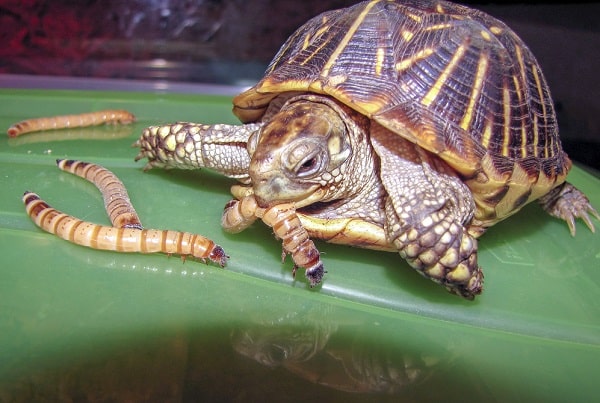
As you probably are aware, different types of foods provide different nutrients.
Bright red vegetables are typically high in vitamin A, vitamin C, and manganese, while dark leafy greens supply ample potassium, folate, and vitamin E.
To give your box turtle the healthiest diet possible, you should not only try to mimic its natural diet as much as you can, but also offer a wide variety of plant matter and protein sources. After all, variety is the spice of life!
Vitamin A
Vitamin A deficiency is a common issue for captive box turtles.
In a general sense, this ailment is avoidable by feeding a diet filled with fresh fruits and vegetables (with lots of variety).
Vitamin A deficiency in turtles typically results in respiratory infections, ear abscesses, and eye infections.
Foods that are naturally high in Vitamin A and safe to feed box turtle's include:
- Carrots
- Broccoli
- Cantaloupe
- Squash
- Sweet potato
Calcium and Phosphorous
As with most reptiles, proper calcium to phosphorus ratio is vital.
In fact, given that their armor-tough shell is made mostly of calcium, you might even consider this nutrient to be even more imperative for box turtles than many other reptile species.
Aim for a Calcium:Phosphorus ratio of 1.5:1 to 2:1.
The proper balance in each food source offered is not too important, so long as you aim for that average across the entire diet.
For example, if you offer a banana with a calcium to phosphorus ratio of only 0.3:1, you could balance that meal out with beet greens, which feature a hefty ratio of 3:1.
High Calcium:Phosphorus PLANT Foods (Best Foods)
- Collard Greens (14.5:1)
- Mustard Spinach/Tendergreen (7.5:1)
- Papaya (4.8:1)
- Turnip Greens (4.5:1)
- Oranges (2.9:1)
Low Calcium:Phosphorus PLANT Foods (Limited Amounts)
- Green Peas (0.2:1)
- Bananas (0.2:1)
- Zucchini Squash (0.2:1)
- Yam/Sweet Potato (0.3:1)
- Tomatoes (0.4:1)
Low-calcium protein sources should also be dusted with a reptile calcium powder or crushed cuttlebone.
You can do this up to a few times a week but be aware that excessive calcium can cause issues as well.
High Calcium:Phosphorus PROTEIN Foods (Best Foods)
- Black Soldier Fly Larvae (1.5:1)
- Earthworms (1.5:1)
- Nightcrawlers (1.5:1)
- Dog food (~1:1)
- Pinkie mice (0.9:1)
Low Calcium:Phosphorus PROTEIN Foods (Limited Amounts)
- Butterworms (0.05:1)
- Superworms (0.06:1)
- Mealworms (0.07:1)
- Chicken breast (0.07:1)
- Crickets (0.1:1)
It may also be beneficial to keep a piece of whole cuttlebone in your boxie's enclosure.
Not only will this supply supplemental calcium, but it is also a source of enrichment and can help to keep the turtle's beak filed down.
Foods to Avoid Feeding Your Box Turtle
Box turtles are so opportunistically omnivorous that the list of foods they can't eat is shorter than the list of foods they can, and should, eat!
Still, it is crucial to address these items, so owners do not mistakenly make their pet sick by doing the right thing and varying their diet.
Never feed your box turtle any of the following foods:
- Rhubarb
- Tobacco leaves
- Tomato leaves
- Potato leaves
- Avocado skins or pits
- Poison ivy and other irritating plants
- Substrate
- Grains, breads, baked goods, and pasta
- Candy
- Processed meat
- Dairy products
- Processed foods in general, besides commercial dog food and box turtle diet (limit to <10% of their total diet)
How to Deal With a Box Turtle That Won't Eat
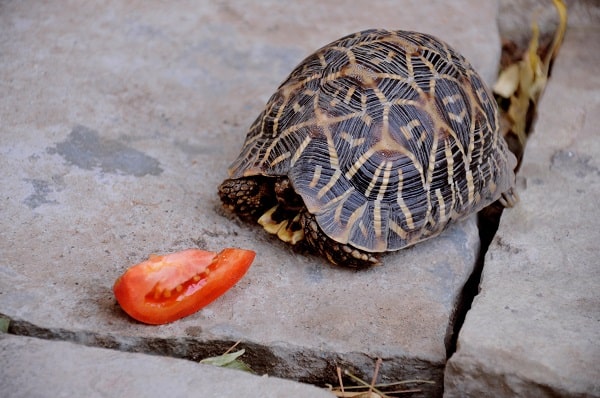
Beyond overall pickiness, it's not uncommon for box turtles to go on hunger strikes or to suddenly only eat one type of food when they were perfectly content eating a healthy, varied diet last week.
Many owners of box turtles and other land-based chelonians, like tortoises, find that they have a hard time convincing their reptilian friend to eat healthy foods, like dark leafy greens or squash.
After all, most box turtles are naturally drawn to insects and bright, soft fruits.
Beyond their own stubbornness, a flat out refusal to eat may also be a sign of stress or preparation for a change in the seasons.
Tips for Getting Your Box Turtle to Eat if You Encounter a Complete Hunger Strike:
Tip #1: Offer food to your box turtle at dusk, dawn, or late morning, after they've had a chance to warm up.
Tip #2: Offer food to your box turtle after a natural rainfall, thunderstorm, or after misting them and their enclosure.
Tip #3: Offer food in a sheltered area, like in a hide box or underneath a shrub.
Tip #4: If you are housing more than one box turtle together, make sure there is at least one sheltered feeding spot for each turtle, or try separating them during mealtime.
Tip #5: Avoid placing food in direct sunlight, especially during Summer.
Tip #6: Provide full-spectrum lighting to indoor boxies.
Tip #7: Feed a diet of foods rich in vitamin A to avoid the lethargy and lack of appetite associated with vitamin A deficiency.
Tip#8: If all else fails, set up an appointment with your experienced reptile veterinarian to run diagnostic tests and ensure that your pet doesn't become too weak or develop a vitamin deficiency.
Dealing With Picky Eaters
If your box turtle has become obsessed with one food item, try serving it mixed with other types of food.
For example, if your turtle loves all kinds of worms but refuses to eat any veggies, try mixing chopped up worms with chopped squash to coax them into realizing that squash is food too.
If your turtle loves pumpkin but hates protein-rich foods, then mashing some mealworms in with pumpkin can make your boxie acquire a taste for bugs.
You should aim to offer food from each food group for most meals, even if your box turtle ignores certain foods. He or she may eventually surprise you.
Feeding the same food item for multiple meals is typically how box turtles develop favorites and picky eating habits.
Lighting and Diet
For turtles kept indoors, UVA- and UVB-producing fluorescent lights are strongly recommended for various reasons, unless they have access to plenty of natural sunlight.
Proper lighting will have numerous positive effects on the turtle, including increased appetite.
Full-spectrum light is required for vitamin D3 production and calcium absorption.
The basking light should be provided for 10-12 hours per day, then turned off at night.
If your box turtle is kept indoors, especially if you opt-out of providing full-spectrum lighting, sprinkle their food with a vitamin D3 supplement, or, better yet, a complete reptile multi-vitamin.
Temperature for Digestion
As with all other ectothermic (cold-blooded) animals, like reptiles, adequate environmental temperatures are necessary for your turtle to digest its food.
If nighttime temperatures fall below 65°F, your box turtle will need to bask and warm up for several hours in the morning before it will be interested in eating.
If the daytime temperatures are below 65°F, you should bring your box turtle inside, or it will attempt to hibernate by burrowing deep within its substrate.
The ideal daytime basking temperature for proper digestion is 85-87°F.
Don't Forget to Offer Water
Your box turtle should always have access to clean, fresh water in a shallow container that they can climb into and won't drown. It should be deep enough to allow them to wade and partially soak.
Boxies often use their water bowl as their toilet, so it's essential to wash the dish and refill it every day.
There are some critical differences between feeding baby box turtles and adult box turtles.
Hatchlings and growing adolescents typically require more frequent meals with higher amounts of protein, while adult box turtles eat less often, more plant materials, and lower-fat protein sources.
Sourcing Your Box Turtle's Food
Where you buy or source your reptile's food is just as important as what you are feeding it.
Many reptile keepers advocate feeding only organic produce and with sound reasoning.
Every year, discoveries are made regarding additives, pesticides, preservatives, and colorants sprayed onto our food causing long-term health issues for humans.
The fact of the matter is that we hardly understand which artificial additives aren't healthy for humans, let alone an entirely different species, like box turtles.
With a lifespan commonly surpassing the 30-year mark in captivity, box turtles easily live long enough to accumulate the pesticides and other pollutants found on conventional produce.
If you can't afford, source, or grow your own organic produce, be sure to thoroughly rinse conventional produce before offering it to your pet.
Expert Tip: It can also be fun to supplement your boxie's store-bought diet with more "exotic" insects and plants from your own backyard! Just make sure that your yard is organically grown, with no artificial fertilizers, pesticides, or herbicides. The safest bet is to make sure that your neighbors aren't spraying any poisonous chemicals in their adjacent yards, either.
If your yard is toxin-free, small spiders, snails, grasshoppers, anoles, non-toxic flowers, grasses, and leaves can all be considered fair game!
Bring your box turtle outside or build an outdoor enclosure so they can forage for themselves, too.
In terms of feeder insects, another habit that enthusiasts are wary of is purchasing nightcrawlers and red wigglers from bait shops.
Since these worms were not grown for pet consumption, there is little to no quality control regarding pollutants and chemicals.
Many times, they are farmed underneath rabbit cages, causing them to carry unwanted parasites and bacteria.
Source: https://www.boxturtles.com/what-do-box-turtles-eat/
Post a Comment for "What Csn You Feed a Wild Box Turtle"